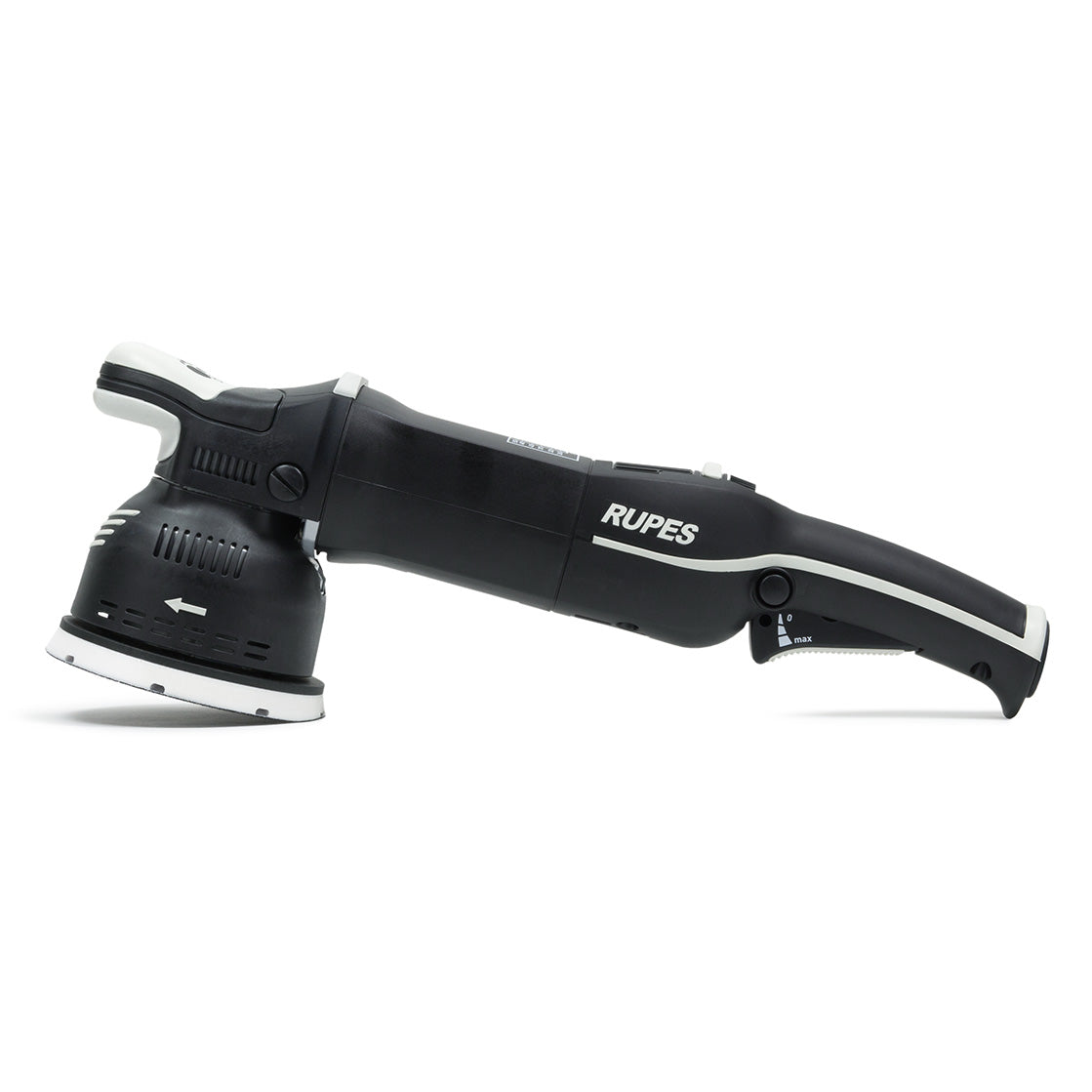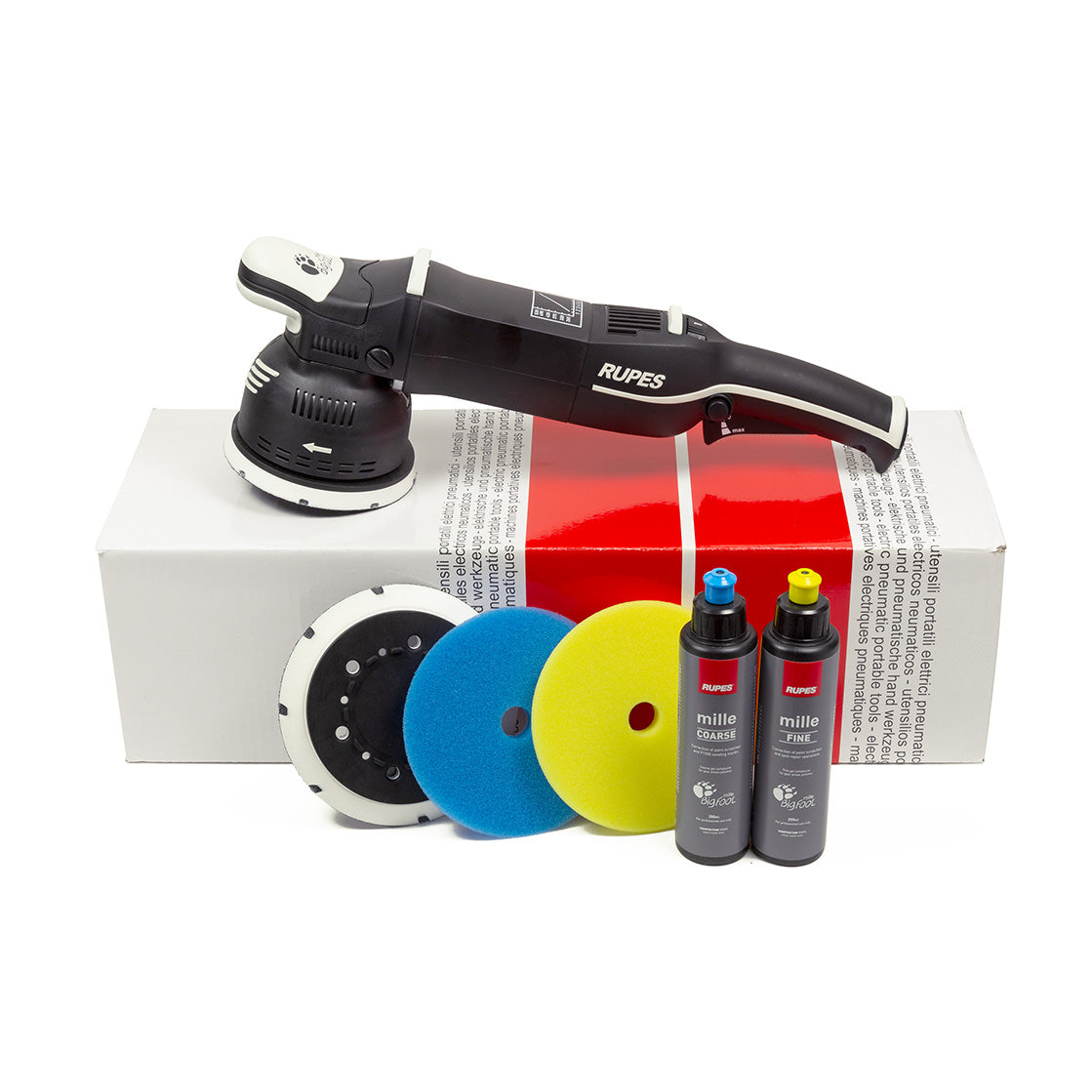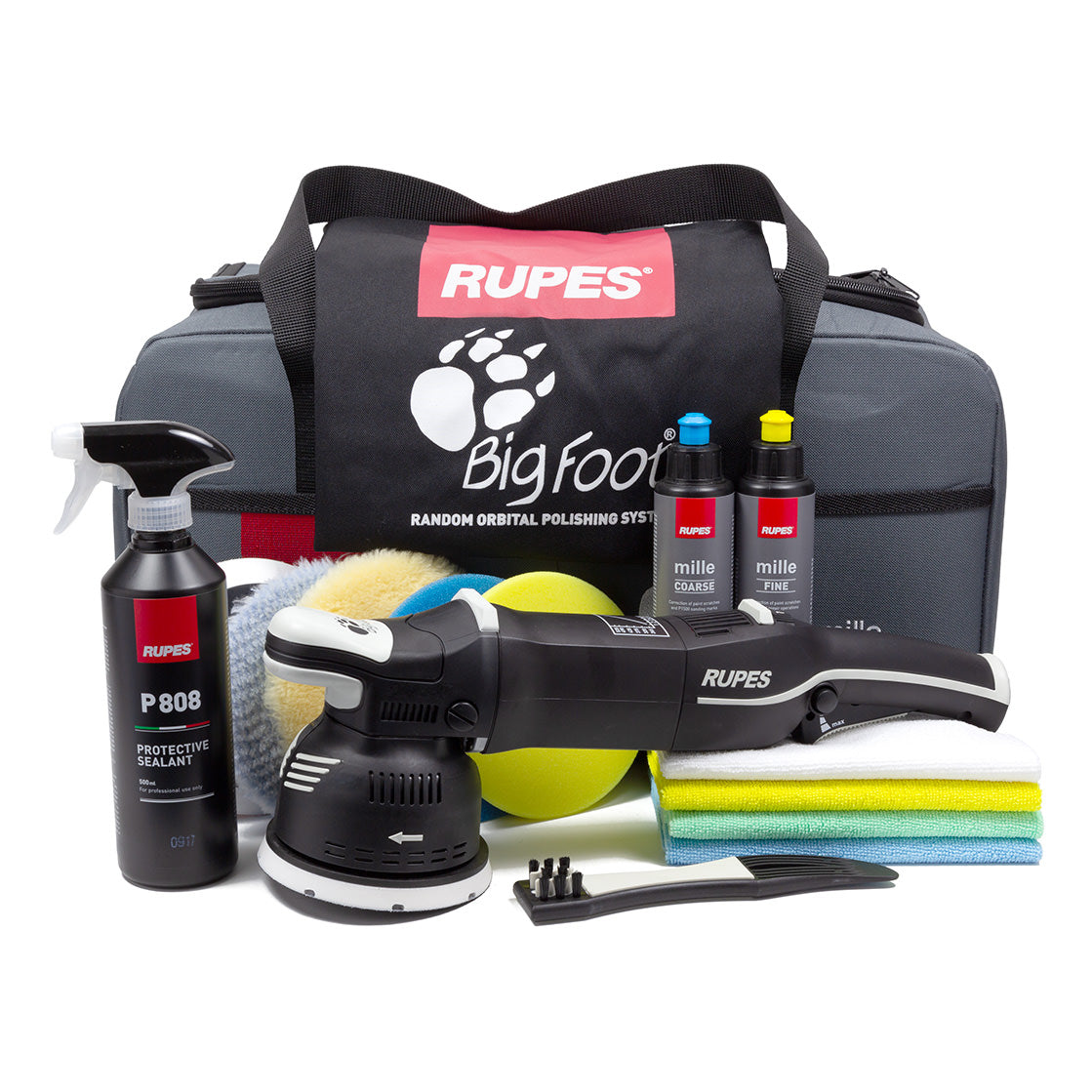

We Say
In contrast to other BigFoot polishers, the RUPES LK 900E BigFoot Mille features a powerful 900 watt motor with a gear-driven rotary movement (265 - 535 RPM) that operates in conjunction with a short-throw random orbital movement (3710 - 7490 OPM). This combined action offers numerous advantages compared to single action rotary polishers and free-spinning dual action machines. Firstly, the rotary movement ensures that the polishing pad continues to rotate at a consistent speed regardless of the curvature of the surface being polished or how much downward pressure is being applied. As a result, the polishing pad never bogs down or stalls, meaning it's easier to produce consistent results on complex panel shapes and edges compared to using free-spinning dual action machines. Secondly, thanks to the orbital movement, frictional heat is generated more slowly, meaning that the chances of overheating or burning the paint are minimised compared to using single action rotary polishers. Furthermore, the orbital movement also ensures that swirls and holograms are not formed during the polishing process, which saves time by eliminating the need for additional refining steps.
In keeping with the globally renowned BigFoot design philosophy, the RUPES LK 900E BigFoot Mille also features a lightweight, ergonomically-efficient, low-profile body with a sculpted head that makes it supremely comfortable to hold, and speed controls (progressive trigger, speed selection dial and trigger lock) that are all within easy reach of the main control handle. Indeed, it is the perfect tool for experienced enthusiasts and professional detailers looking to extend their paint correction abilities without exposing themselves to the risks associated with rotary polishing. Furthermore, by opting to use a very short-throw random orbital movement and developing a carefully engineered range of proprietary backing plates and low-profile pads, RUPES have produced a beautifully balanced machine that runs very smoothly and isn't plagued by the horrible vibrations usually associated with dual action polishers. Although it isn't quite as easy to use as free-spinning random orbital machines, due to a small amount of torque steer produced by the clockwise rotary movement, it is by far the most user-friendly gear-driven dual action polisher currently available.
Key Features
Description
RUPES LK 900E BigFoot Mille - STN Kit
This kit comprises...
1 x RUPES LK 900E BigFoot Mille
1 x RUPES Mille Backing Plate (125 mm)
1 x RUPES Mille Backing Plate (150 mm)
1 x RUPES Mille Coarse Foam Polishing Pad (140 mm)
1 x RUPES Mille Fine Foam Polishing Pad (140 mm)
1 x RUPES Mille Coarse Gel Compound (250 ml)
1 x RUPES Mille Fine Gel Compound (250 ml)
RUPES LK 900E BigFoot Mille - DLX Kit
This kit comprises...
1 x RUPES LK 900E BigFoot Mille
1 x RUPES Mille Backing Plate (125 mm)
1 x RUPES Mille Backing Plate (150 mm)
1 x RUPES Mille Coarse Foam Polishing Pad (140 mm)
1 x RUPES Mille Fine Foam Polishing Pad (140 mm)
1 x RUPES BigFoot Coarse Wool Polishing Pad (145 mm)
1 x RUPES BigFoot Medium Wool Polishing Pad (145 mm)
1 x RUPES Mille Coarse Gel Compound (250 ml)
1 x RUPES Mille Fine Gel Compound (250 ml)
1 x RUPES Protective Sealant (500 ml)
1 x RUPES BigFoot Buffing Towels (Pack of 4)
1 x RUPES BigFoot Claw Pad Tool
1 x RUPES BigFoot Detailing Apron
1 x RUPES Mille Semi-Rigid Storage Bag
Specification
| AC-Powered | Yes |
|---|---|
| Battery Type | n/a |
| Battery-Powered | No |
| CE Approved | Yes |
| Cable Length | 8.7 m |
| Drive Type | Random orbital (gear-driven) |
| Interchangeable Backing Plate | Yes (125 mm, 150 mm) |
| Net Weight | 2.8 kg |
| Orbital Throw | 5 mm |
| Plug Type | UK 3-pin (G) |
| Power Rating | 900 W |
| Running Time | n/a |
| Soft Start | Yes |
| Sound Pressure Level | 84 dB(A) |
| Speed Lock | Yes |
| Speed Range | 265 - 535 RPM and 3710 - 7490 OPM |
| Supplied Backing Plate | 125 mm and 150 mm |
| Thread Size | 6 x M4 (fixing bolts supplied) |
| Variable Speed Control | Yes |
| Vibration Level (3 Axis) | 6.0 m/s² |
| Voltage | 230 V |
| Warranty | 1 year return to base |
How To Use
The RUPES LK 900E BigFoot Mille is a power tool and thus subject to a number of health and safety risks that should be fully understood from the outset; please read the supplied instructions carefully. Please also visit the links to the backing plate, polishing pad and polishing compound pages provided in the Description section above, and read their How To Use sections carefully. Doing so will help to ensure you obtain the best results from your new machine.
Recommended method for correcting soft paint using the Mille:
To correct obvious swirl marks and other common paint defects, start out with RUPES Mille Fine Gel Compound on a RUPES Mille Fine Foam Polishing Pad. Working at a low to moderate machine speed, with moderate arm speed and light pressure, should enable you able to correct a large proportion of the defects in just 1-2 attempts per 18 x 18 area. If your paint is in bad condition and you subsequently find that more correction is needed, switch to RUPES Mille Fine Gel Compound on a RUPES BigFoot Medium Wool Polishing Pad - this combination offers more cutting power, but should be used sparingly, as the rate of paint removal increases significantly. When you are happy with the level of correction, follow up again with RUPES Mille Fine Gel Compound on a RUPES Mille Fine Foam Polishing Pad, in order to maximise surface gloss. If you want to take the finish further, you may wish to perform an extra jewelling step with RUPES Mille Ultra Fine Gel Compound on a RUPES Mille Ultra Fine Foam Polishing Pad prior to applying your favourite last step product.
Recommended method for correcting intermediate paint using the Mille:
To correct obvious swirl marks and other common paint defects, start out with RUPES Mille Fine Gel Compound on a RUPES Mille Fine Foam Polishing Pad. Working at a moderate to high machine speed, with low arm speed and light to moderate pressure, should enable you able to correct a large proportion of the defects in just 1-2 attempts per 18 x 18 area. If your paint is in bad condition and you subsequently find that more correction is needed, switch to RUPES Mille Coarse Gel Compound on a RUPES Mille Coarse Foam Polishing Pad - this combination offers more cutting power, but should be used sparingly, as the rate of paint removal increases significantly. When you are happy with the level of correction, follow up with RUPES Mille Fine Gel Compound on a RUPES Mille Fine Foam Polishing Pad, in order to maximise surface gloss. If you want to take the finish further, you may wish to perform an extra jewelling step with RUPES Mille Ultra Fine Gel Compound on a RUPES Mille Ultra Fine Foam Polishing Pad prior to applying your favourite last step product.
Recommended method for correcting hard paint using the Mille:
To correct obvious swirl marks and other common paint defects, start out with RUPES Mille Coarse Gel Compound on a RUPES Mille Coarse Foam Polishing Pad. Working at a moderate to high machine speed, with low arm speed and light to moderate pressure, should enable you able to correct a large proportion of the defects in just 1-2 attempts per 18 x 18 area. If your paint is in bad condition and you subsequently find that more correction is needed, switch to RUPES Mille Coarse Gel Compound on a RUPES BigFoot Coarse Wool Polishing Pad - this combination offers much more cutting power, but should be used with caution, as the rate of paint removal increases significantly. When you are satisfied with the level of correction, follow up with RUPES Mille Fine Gel Compound on a RUPES Mille Fine Foam Polishing Pad, in order to maximise surface gloss. If you want to take the finish further, you may wish to perform an extra jewelling step with RUPES Mille Ultra Fine Gel Compound on a RUPES Mille Ultra Fine Foam Polishing Pad prior to applying your favourite last step product.
General usage notes:
(i) always wear earplugs and safety spectacles when using a machine polisher; (ii) always tie back long hair and tuck away anything else that could accidentally get caught up (e.g. necklaces or headphone cables); (iii) always switch off your machine at the mains before fitting or swapping the backing plate; (iv) always route the cable up and over your opposite shoulder so as to avoid it coming into contact with the car; (v) always ensure that the pad is in contact with the bodywork when you switch the machine on and off - if you don't do this it's likely to fly off at high speed; (vi) always familiarise yourself fully with the instructions provided for the pads and polishes you are using, and adjust your technique accordingly (e.g. tool speed, arm speed and pressure); (vii) always let the machine do the bulk of the work - there is rarely any need to exert heavy pressure when machine polishing (if the current pad and polish you are using aren't delivering sufficient cut, step up to a more aggressive combination rather than trying to force the issue); (viii) always take a break if you notice that the machine is becoming hot during use - hot machines tend to transmit heat down into the backing plate and pad, which can result in the pad failing prematurely; (ix) always lay the machine on its back when it's not in use, to prevent the pad coming into contact with the ground, and; (x) avoid stepping on the power cable at all times.



